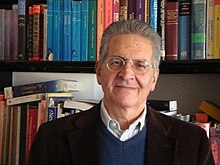Filippo Frontera

.
Filippo Frontera (born November 16, 1941 in Savelli ) is an Italian astrophysicist who deals with gamma-ray astronomy.
In 1998 he received as part of the BeppoSAX teams the Bruno Rossi Prize for observation of X-ray afterglow of a gamma-ray burst (gamma ray burst), followed by observations at other wavelengths, a distance determination has been made possible. Frontera was responsible for the Phoswich Detector System (PDS) and the Gamma Ray Burst Monitor (GRBM) on the satellite. Enrico Costa was also significantly involved in the project .
He is also primarily concerned with X-ray astronomy and was involved in the development of the JEM-X experiment on the integral satellite and in balloon experiments on X-ray astronomy (in Italy, France, the USA and Australia). Currently (2012) at the IASF in Bologna he is developing a lens for hard X-rays (energies from 70 to 100 keV) for use in satellites, prototypes of which have already been successfully tested.
From 1969 to 1985 Frontera was at the Italian National Institute for Astrophysics and Space Physics (Istituto di Astrofisica e Fisica dello Spazio, IASF) in its branch in Bologna and is a professor at the University of Ferrara . There he heads the group for high energy astronomy. He also heads the university's doctoral program in physics (2012).
In 2010 he received the Premio Enrico Fermi with Costa . In 2002 he was a member of Ed van den Heuvel's team and won the Descartes Prize . In 2012 he received the Marcel Grossmann Award.
Web links
Individual evidence
- ↑ J. van Paradijs, Frontera et al. a. Transient optical emission from the error box of the γ-ray burst of February 28, 1997 , Nature, Volume 386, 1998, pp. 686-689, abstract
- ↑ Costa, Frontera et al. a. Discovery of an X-ray afterglow associated with the γ-ray burst of February 28, 1997 , Nature, Volume 387, 1997, pp. 783-785, bibcode : 1997Natur.387..783C
- ↑ Formerly TESRE
| personal data | |
|---|---|
| SURNAME | Frontera, Filippo |
| BRIEF DESCRIPTION | Italian astrophysicist |
| DATE OF BIRTH | November 16, 1941 |
| PLACE OF BIRTH | Savelli |